10GBASE-KR介绍及仿真优化
- 格式:pdf
- 大小:3.87 MB
- 文档页数:64
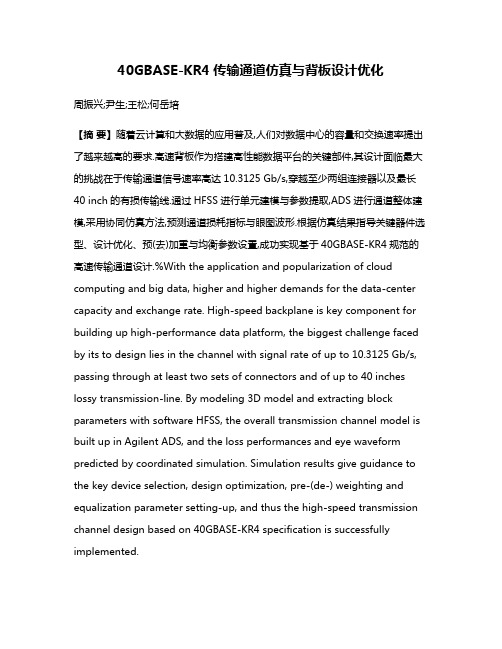
40GBASE-KR4传输通道仿真与背板设计优化周振兴;尹生;王松;何岳培【摘要】随着云计算和大数据的应用普及,人们对数据中心的容量和交换速率提出了越来越高的要求.高速背板作为搭建高性能数据平台的关键部件,其设计面临最大的挑战在于传输通道信号速率高达10.3125 Gb/s,穿越至少两组连接器以及最长40 inch的有损传输线.通过HFSS进行单元建模与参数提取,ADS进行通道整体建模,采用协同仿真方法,预测通道损耗指标与眼图波形.根据仿真结果指导关键器件选型、设计优化、预(去)加重与均衡参数设置,成功实现基于40GBASE-KR4规范的高速传输通道设计.%With the application and popularization of cloud computing and big data, higher and higher demands for the data-center capacity and exchange rate. High-speed backplane is key component for building up high-performance data platform, the biggest challenge faced by its to design lies in the channel with signal rate of up to 10.3125 Gb/s, passing through at least two sets of connectors and of up to 40 inches lossy transmission-line. By modeling 3D model and extracting block parameters with software HFSS, the overall transmission channel model is built up in Agilent ADS, and the loss performances and eye waveform predicted by coordinated simulation. Simulation results give guidance to the key device selection, design optimization, pre-(de-) weighting and equalization parameter setting-up, and thus the high-speed transmission channel design based on 40GBASE-KR4 specification is successfully implemented.【期刊名称】《通信技术》【年(卷),期】2017(050)007【总页数】6页(P1564-1569)【关键词】云计算;整体建模;协同仿真;眼图【作者】周振兴;尹生;王松;何岳培【作者单位】中国电子科技集团公司第三十研究所,四川成都 610041;中国电子科技集团公司第三十研究所,四川成都 610041;中国电子科技集团公司第三十研究所,四川成都 610041;中国电子科技集团公司第三十研究所,四川成都 610041【正文语种】中文【中图分类】TP393随着云计算和大数据的应用普及,人们对于数据中心的容量和数据交换的速率提出了越来越高的要求。
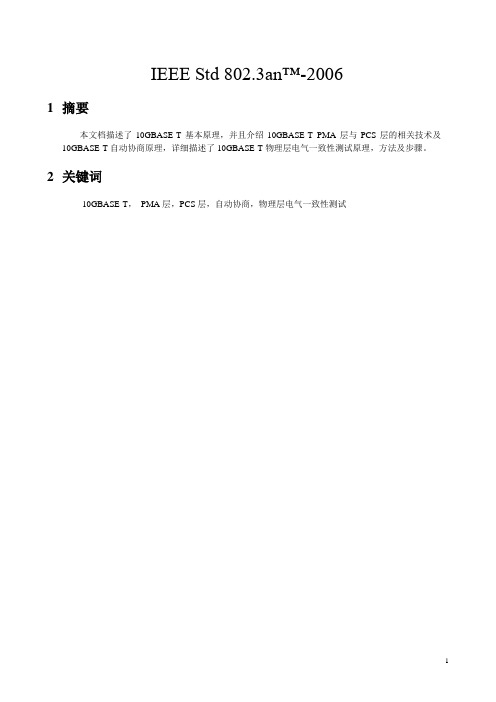
IEEE Std 802.3an™-20061摘要本文档描述了10GBASE-T基本原理,并且介绍10GBASE-T PMA层与PCS层的相关技术及10GBASE-T自动协商原理,详细描述了10GBASE-T物理层电气一致性测试原理,方法及步骤。
2关键词10GBASE-T,PMA层,PCS层,自动协商,物理层电气一致性测试3概述3.110GBASE-T技术目标支持自动协商,以全双工基带的传输方式在至少100m长度的4对线缆上传输满足IEEE 802.3标准的帧,要求BER<=10e-12,同时满足CISPR/FCC Class A EMC要求(商业或工业使用);3.2OSI参考模型与IEEE 802.3 CSMA/CD局域网模型说明:●10GBASE-T PHY组件由10GBASE-T PCS, 10GBASE-T PMA, 10GBASE-T AN和10GBASE-TMDI组成;●PCS子层使用了LDPC前向纠错和多位PAM16编码;●PMA子层在8芯4线对的Cat6A双绞线上实现4路捆绑的同时收发功能;●AN功能将自动协商延伸到万兆;●MDI接口使用扩展6类RJ45连接器,在高性能扩展6类线上可以传输100m距离;TransmitterReceiverSelf-synchronizing scrambler - Provides clock transitions, and a statistically random power spectrum for EMI control, equalizer convergence, etc.DSQ 128 coding - The 10GBASE-T standard uses a synthetic 2-dimensional 128 DSQ (Double SQuare) constellation, which conveys 7 bits per symbol.LDPC (Low Density Parity Check) block codes – Block codes are one of two kinds of error correcting codes that can be used to approach the Shannon capacity of a channel.Tomlinson-Harashima Precoding (THP) - The 10GBASE-T standard calls for the use of THP, which is a scheme in which the equalizer for the channel is placed in the transmitter theoretically allowing the receiver to see “perfect”symbols. Training is accomplished during the initialization phase of the link.3.3操作概述10GBASE-T PHY实现的技术方案非常复杂,IEEE 802.3an标准将10GBASE-T的运行概述如下:●10GBASE-T PHY组件在四线对平衡型布缆上采用全双工基带传输;●每个线对上双向同时以2500Mb/s传输,4线对捆绑达到10Gb/s的速率;●每个线对的调制速率为800MBd(波特,或symb/s),调制方式为PAM16(基带16电平脉冲幅度调制);●两个连续传输的PAM16信号作为一个二维(2D)符号,选自一个极大化2D符号分离的特点128点星座,即DSQ128(双矩形)星座;4bit(㏒2 16)形成一个16级的脉冲幅度调制信号,每个16级PAM值作为一个PAM16符号,一对PAM16符号组成1个二维(2D)编码,从而形成256(16×16)个正交值的星座,从16×16矩阵中精减交叉的点形成128个2D符号,最终的DSQ128星座如下图,(在二维上使用值:-15, -13, -11, -9, -7, -5, -3, -1, +1, +3, +5, +7, +9, +11, +13, +15);Figure: DSQ128 Constellation与传统16x16的正交阵列相比,相邻DSQ128编码的距离增加了√2倍,这提高了3dB的信噪比,从而可以有效减少误码率(BER);●链路启动后连续发送PHY帧(512个DSQ128符号),DSQ128符号由7比特(㏒2 128)标签确定,标签由3个未编码比特加上4个LDPC编码比特构成(PCS层);Figure: DSQ128 Code block with LDPC (1723, 2048)●一个PHY帧的512个DSQ128符号作为4×256的PAM16符号在四线对上传输,数据和控制符统一成帧,在链路启动后连续传输;●编码速率为3.125信息位/符号,信息位包括以太网数据与控制符,以及辅助信道的比特;当计算10GBASE-T系统数据吞吐量时,需要考虑成帧和代码块的开销:A.4bit编码数据:由于增加了325个检验bit,最终形成2048 LDPC编码块,实际编码数据降为1723/2048=3.3652 bitB.3bit未编码数据:无额外开销;C.因此每个DSQ128符号的平均数据bit是3+3.3652=6.3652bitD.由于两个PAM16符号形成1个DSQ128符号,因此PAM16符号的平均数据bit减半为6.3652bit/2=3.1826 bitsE.增加物理层64B/65B块编码,帧同步和CRC的开销,最终PAM16符号的平均bit数减为3.125 bits,计算过程如下:XGMII输入50个64bit,即64*50=3200 bits,经过64B/65B编码,扰码,增加1bit辅助位和8bit CRC,输出50*65+8+1=3259 bits,效率为3200/3259=0.9819;即3.1826*0.9819=3.12498;●10GBASE-T的数据吞吐量:800MBd(调制率) ×3.125bit/symb(编码率) ×4(线对)= 10Gbit/s(四路捆绑传输总速率) 1000BASE-T:125MBd×2bit/symb×4=1Gbit/s●以太网标准化组织(IEEE 802.3)与线缆标准化组织(TIA TR42)合作第一次协调了网络接口标准(10GBASE-T)与线缆标准(Cat6A,Category 6 Augmented)的制订,EIA/TIA 568B.2-10标准是定义扩展6类双绞线Cat6A的规范;术语组件/通道:●扩展6类线的有效带宽扩展到了500MHz,但在6类线有效带宽的250MHz以内的指标值与6类线原有的保持一致;PAM16符号率是800 MSymbols/秒(800Mbaud),根据奈奎斯特采用原理,要求基带频率为400 MHz的信号,在实际实现过程中PAM编码一般要求10~15%的余量要求,因此10GBASE-T线缆的带宽被规定到至少500MHz,从而为信号传输提供适当的余量;●10GBASE-T规范继承100BASE-T2和1000BASE-T的技术思路,主要包括:A.采用混合与抵消,在双绞线上实现全双工运行;B.多线对(2对或4对)捆绑传输已达到要求的速率;C.采用多维PAM调制,实现双绞线上的基带传输;D.调制编码合一,采用FEC纠错;1000Base-T 10GBase-T传输方式全双工带回声抑制全双工带回声抑制调制技术5级脉冲调幅技术16级脉冲调幅技术码元比特率 2 bit/码元 3.125bit/码元码元传输率125M/秒*线对800M/秒*线对工作带宽要求80MHz 417Mhz信道编码4D 8-state网格编码(trellis 编码)128-DSQ+LDPC(2048,1723)THP 预编码FEXT干扰推荐使用FEXT干扰消除必须使用FEXT干扰消除双绞线接口以太网对比410GBase-T Physical Coding Sublayer(PCS )4.1PCS功能发送1. XAUI/XFI接口;2. 扰码,成帧-》Sum bits: 1+65*50+8=3259=512*3(uncoded)+1723(coded)3. LDPC编码-》add 325 parity bits to blocks of 1723 data bits.c=xGG : the code generator matrixx : 1723-bit input vector;c :2048 output code vector;[c0 c1 (2043)[x0 x1 ... x1772]325个校验位是用来保护每个1723位编码数据块的完整性,从而形成一个2048位的LDPC码字。

Cisco 10GBASE SFP+ModulesData sheet Cisco publicContentsProduct overview 3 Features and benefits 3 Cisco SFP-10G-T-X module 4 Cisco SFP-10G-SR-S module (S-Class) 4 Cisco SFP-10G-SR module 4 Cisco SFP-10G-SR-X module 5 Cisco SFP-10G-SR-I module 5 Cisco SFP-10G-LRM module 5 Cisco FET-10G module 5 Cisco SFP-10G-LR-S module (S-Class) 5 Cisco SFP-10G-LR module 5 Cisco SFP-10G-LR-X module 6 Cisco SFP-10G-LR10-I module 6 Cisco SFP-10G-ER-S module (S-Class) 7 Cisco SFP-10G-ER module 7 Cisco SFP-10G-ER-I module 7 Cisco SFP-10G-ZR-S module (S-Class) 7 Cisco SFP-10G-ZR module 7 Cisco SFP-10G-ZR-I module 8 Cisco SFP+ Twinax copper cables 8 Cisco SFP+ Active optical cables 9 Platform support 9 Product specifications 10 Warranty 19 Cisco environmental sustainability 19 Ordering information 20 Regulatory and standards compliance 21 Cisco Capital 22 Next steps 22 Document history 23A broad range of industry-compliant SFP+ modules for 10 Gigabit Ethernet deploymentsin diverse networking environments.Product overviewThe Cisco® 10GBASE SFP+ modules (Figure 1) give you a wide variety of 10 Gigabit Ethernet connectivity options for data center, enterprise wiring closet, and service provider transport applications.Figure 1.Cisco 10GBASE SFP+ modulesFeatures and benefitsCisco SFP+ modules offer the following features and benefits.●Industry’s smallest 10G form factor for greatest density per chassis●Hot-swappable input/output device that plugs into an Ethernet SFP+ port of a Cisco switch (no need topower down if installing or replacing)●Supports “pay-as-you-populate” model for investment protection and ease of technology migration●Digital optical monitoring capability for strong diagnostic capabilities●Optical interoperability with 10GBASE XENPAK, 10GBASE X2, and 10GBASE XFP interfaces on the samelink●Cisco quality Identification (ID) feature enables a Cisco platform to identify whether the module iscertified and tested by CiscoCisco SFP-10G-T-X moduleThe Cisco 10GBASE-T module (Figure 2) offers connectivity options at the following data rates:100M/1G/10Gbps. It has the SFP+ form factor and an RJ-45 interface so that CAT5e/CAT6A/CAT7 cables can be used to connect to end points with embedded 10GBASE-T ports. They are suitable for distances up to 30 meters and offers a cost-effective way to connect within racks and across adjacent racks.Figure 2.Cisco SFP+ 10GBASE-T module with RJ-45 connectorTable 1, details the specifications for the SFP-10G-T-X module, including cable type, distance, and data rates supported.Table 1.SFP-10G-T-X cabling specificationsCisco SFP-10G-SR-S module (S-Class)The Cisco 10GBASE-SR module supports a link length of 26 meters on standard Fiber Distributed Data Interface (FDDI)-grade Multimode Fiber (MMF). Using 2000 MHz*km MMF (OM3), up to 300-meter link lengths are possible. Using 4700 MHz*km MMF (OM4), up to 400 meter link lengths are possible. SFP-10G-SR-S does not support FCoE.Cisco SFP-10G-SR moduleThe Cisco 10GBASE-SR Module supports a link length of 26m on standard Fiber Distributed Data Interface (FDDI)-grade Multimode Fiber (MMF). Using 2000MHz*km MMF (OM3), up to 300m link lengths are possible. Using 4700MHz*km MMF (OM4), up to 400m link lengths are possible.Cisco SFP-10G-SR-X moduleThe Cisco SFP-10G-SR-X is a multirate* 10GBASE-SR, 10GBASE-SW and OTU2/OTU2e module for extended operating temperature range. It supports a link length of 26m on standard Fiber Distributed Data Interface (FDDI)-grade Multimode Fiber (MMF). Using 2000MHz*km MMF (OM3), up to 300m link lengths are possible. Using 4700MHz*km MMF (OM4), up to 400m link lengths are possible.* Except for version 1, which supports only 10GBASE-SR.Cisco SFP-10G-SR-I moduleThe Cisco SFP-10G-SR-I is a multirate 10GBASE-SR, 10GBASE-SW and OTU2/2e module for industrial operating temperature range. This module also supports CPRI datarate options 3, 4, 5, 6, 7, 7a, 8. It supports a link length of 26m on standard Fiber Distributed Data Interface (FDDI)-grade Multimode Fiber (MMF). Using 2000MHz*km MMF(OM3), up to 300m link lengths are possible. Using 4700MHz*km MMF (OM4), up to 400m link lengths are possible.Cisco SFP-10G-LRM moduleThe Cisco 10GBASE-LRM Module supports link lengths of 220m on standard Fiber Distributed Data Interface (FDDI) grade Multimode Fiber (MMF). To make sure that specifications are met over FDDI-grade, OM1 and OM2 fibers, the transmitter should be coupled through a mode conditioning patch cord. No mode conditioning patch cord is required for applications over OM3 or OM4. For additional information on mode conditioning patch cord requirements please see:https:///en/US/prod/collateral/modules/ps5455/product_bulletin_c25-530836.html.The Cisco 10GBASE-LRM Module also supports link lengths of 300m on standard Single-Mode Fiber (SMF, G.652).Cisco FET-10G moduleThe Cisco FET-10G Fabric Extender Transceiver supports link lengths up to 100m on laser-optimized OM3 or OM4 multimode fiber. It is supported on fabric links from a Nexus 2000 to a Cisco parent switch only. Note this product is not orderable individually. For more information refer to Nexus 2000 datasheet:https:///en/US/prod/collateral/switches/ps9441/ps10110/data_sheet_c78-507093.html.Cisco SFP-10G-LR-S module (S-Class)The Cisco 10GBASE-LR module supports a link length of 10 kilometers on standard Single-Mode Fiber (SMF) (G.652). SFP-10G-LR-S does not support FCoE.Cisco SFP-10G-LR moduleThe Cisco 10GBASE-LR Module supports a link length of 10 kilometers on standard Single-Mode Fiber (SMF, G.652).Cisco SFP-10G-LR-X moduleThe Cisco SFP-10G-LR-X is a multirate 10GBASE-LR, 10GBASE-LW, and OTU2/OTU2e module for extended operating temperature range. It supports a link length of 10 kilometers on standard Single-Mode Fiber (SMF, G.652).Cisco SFP-10G-LR10-I moduleThe Cisco SFP-10G-LR10-I supports a link length of 10 kilometers on standard Single-Mode Fiber (SMF, G.652). The SFP-10G-LR10-I is for industrial operating temperature range. The SFP-10G-LR10-I also supports CPRI datrates options 3, 4, 5, 6, 7, 7a, 8.Cisco SFP-10G-BXD-I and SFP-10G-BXU-I for 10Km (single-fiber bidirectional applications)The Cisco SFP-10G-BXD-I and SFP-10G-BXU-I SFPs operate on a single strand of standard SMF.A SFP-10G-BXD-I device is always connected to a SFP-10G-BXU-I device with a single strand of standard SMF with an operating transmission range up to 10 km.The communication over a single strand of fiber is achieved by separating the transmission wavelength of the two devices, as depicted in Figure 3. SFP-10G-BXD-I transmits a 1330-nm channel and receives a 1270-nm signal, whereas SFP-10G-BXU-I transmits at a 1270-nm wavelength and receives a 1330-nm signal. Note in Figure 3 the presence of a Wavelength-Division Multiplexing (WDM) splitter integrated into the SFP to split the 1270-nm and 1330-nm light paths. This module also supports CPRI datarate options 3, 4, 5, 6, 7, 7a, 8.*Figure 3.Bidirectional transmission of a single strand of SMFThe SFP-10G-BXD-I and SFP-10G-BXU-I SFPs also support Digital Optical Monitoring (DOM) functions according to the industry-standard SFF-8472 Multisource Agreement (MSA). This feature gives the end user the ability to monitor real-time parameters of the SFP, such as optical output power, optical input power, temperature, laser bias current, and transceiver supply voltage.*Version -02 of SFP-10G-BXD-I and SFP-10G-BXU-I supports the CPRI rates.Cisco SFP-10G-ER-S module (S-Class)The Cisco 10GBASE-ER module supports a link length of up to 40 kilometers on SMF (G.652). SFP-10G-ER-S does not support FCoE.Cisco SFP-10G-ER moduleThe Cisco 10GBASE-ER Module supports a link length of up to 40 kilometers on standard Single-Mode Fiber (SMF, G.652).Cisco SFP-10G-ER-I moduleThe Cisco 10GBASE-ER Industrial Temperature Module supports a link length of up to 40 kilometers on standard Single-Mode Fiber (SMF, G.652). The SFP-10G-ER-I for Industrial Operating Temperature Range is a multirate 10GBASE-ER, 10GBASE-EW and OTU2/2e module.Cisco SFP-10G-BX40D-I and SFP-10G-BX40U-I (for 40Km single-fiber bidirectional applications)The Cisco SFP-10G-BX40D-I and SFP-10G-BX40U-I SFPs operate on a single strand of standard SMF.A SFP-10G-BX40D-I device is always connected to a SFP-10G-BX40U-I device with a single strand of standard SMF with an operating transmission range up to 40 km.The communication over a single strand of fiber is achieved by separating the transmission wavelength of the two devices. SFP-10G-BX40D-I transmits a 1330-nm channel and receives a 1270-nm signal. The SFP-10G-BX40U-I transmits at a 1270-nm wavelength and receives a 1330-nm signal.The SFP-10G-BX40D-I and SFP-10G-BX40U-I SFPs support Digital Optical Monitoring (DOM) functions according to the industry-standard SFF-8472 Multisource Agreement (MSA). This feature gives the end user the ability to monitor real-time parameters of the SFP, such as optical output power, optical input power, temperature, laser bias current, and transceiver supply voltage.Cisco SFP-10G-ZR-S module (S-Class)The Cisco 10GBASE-ZR module supports link lengths of up to about 80 kilometers on standard SMF (G.652). This interface is not specified as part of the 10 Gigabit Ethernet standards and is, instead, built according to Cisco specifications. SFP-10G-ZR-S does not support FCoE.Cisco SFP-10G-ZR moduleThe Cisco SFP-10G-ZR is a multirate 10GBASE-ZR, 10GBASE-ZW, and OTU2/OTU2e module. It supports link lengths of up to about 80 kilometers on standard Single-Mode Fiber (SMF, G.652). This interface is not specified as part of the 10 Gigabit Ethernet standard and is instead built according to Cisco specifications.Cisco SFP-10G-ZR-I moduleThe Cisco SFP-10G-ZR-I is a multirate 10GBASE-ZR, 10GBASE-ZW, and OTU2/OTU2e module for industrial operating temperature range. The SFP-10G-ZR-I has a limiting electrical interface receiver, which does not require EDC PHY on the host board, it can be plugged into any SFP+ port. It supports link lengths of up to 70 kilometers on standard Single-Mode Fiber (SMF, G.652), assuming a fiber chromatic dispersion of20 ps/(nm*km). This interface is not specified as part of the 10 Gigabit Ethernet standard and is instead built according to Cisco specifications. The SFP-10G-ZR-I has a cold start at -40⁰C; the transceiver will be operational except optical traffic is not supported from -40⁰ to -28⁰C, all other low speed features (DOM, I2C, etc.) are operational. The module is fully operational from -28⁰C to 85⁰C.Cisco SFP+ Twinax copper cablesCisco SFP+ Copper Twinax (Figure 4) direct-attach cables are suitable for very short distances and offer a cost-effective way to connect within racks and across adjacent racks. Cisco offers passive Twinax cables in lengths of 1, 1.5, 2, 2.5, 3, 4 and 5 meters, and active Twinax cables in lengths of 7 and 10 meters.Figure 4.Cisco direct-attach twinax copper cable assembly with SFP+ connectorsCisco SFP+ Active optical cablesCisco SFP+ Active Optical Cables (Figure 5) are direct-attach fiber assemblies with SFP+ connectors. They are suitable for very short distances and offer a cost-effective way to connect within racks and across adjacent racks. Cisco offers Active Optical Cables in lengths of 1, 2, 3, 5, 7, and 10 meters.Figure 5.Cisco direct-attach active optical cables with SFP+ connectorsPlatform supportCisco SFP+ modules are supported on a wide range of Cisco switches and routers*:Table 2.Cisco Platforms* Not all devices listed support every module. For details about which modules run in which devices and other compatibility information, refer to the document “Cisco 10 Gigabit Ethernet Transceiver Modules Compatibility Matrix”:https:///en/US/docs/interfaces_modules/transceiver_modules/compatibility/matrix/OL_6974.html.Additional platforms may continually be added; please check the compatibility matrix for the latest information and for the Cisco compatible operating system for each platform.Connectors: Dual LC/PC connector (-SR, -LRM, -LR, -ER, -ZR and FET-10G).Note: Only connections with patch cords with PC or UPC connectors are supported. Patch cords withAPC connectors are not supported. All cables and cable assemblies used must be compliant with the standards specified in the standards section.Product specificationsTable 3 provides cabling specifications for the Cisco SFP+ modules.Table 3.SFP+ port cabling specifications*1 Minimum cabling distance for -SR, -LRM, -LR, -ER modules is 2m, according to the IEEE 802.3ae.*2 Links longer than 30km are considered engineered links as per IEEE 802.3ae.*3 Specified at transmission wavelength.*4 Requires 5 dB 1550nm fixed loss attenuator for < 20km. Attenuator is available as a spare. The part number is 15216 ATT LC 5=. *5 Requires 15dB attenuator if Link Distance < 5km.Requires 10dB attenuator if Link Distance is between 5km and 25km.Requires 5dB attenuator if Link Distance is between 25km and 45km.*6 Requires 15dB attenuator if Link Distance < 5km.Requires 10dB attenuator if Link Distance is between 5km and 15km.Requires 5dB attenuator if Link Distance is between 15km and 25km.Attenuator is available as a spare. The part numbers:●5dB - 15216 ATT LC 5=●10dB - 15216 ATT LC 10=●15dB - 15216 ATT LC 15=a - No FCoE support.b - Links up to 15 km are supported as engineered links as long as channel insertion loss < 6.2 dB. Table 4 lists the main optical characteristics for the Cisco SFP+ modules.Table 4.Optical transmit and receive specifications* Transmitter and receiver power is in average, unless specified.** The launch power shall be the lesser of the class 1 safety limit or the maximum receive power. Class 1 laser requirements are defined by IEC 60825-1: 2001.*** Both average and OMA specifications must be met simultaneously.Table 5 details optical specifications for the Cisco SFP-10G-ZR modules.Table 5.SFP-10G-ZR, SFP-10G-ZR-S optical parameters*Maximum chromatic dispersion for SFP-10G-ZR and SFP-10G-ZR-S is 1600 ps/nm.Note: Parameters are specified over temperature and at end of life unless otherwise noted. When shorter distances of single-mode fiber are used (<40km), an inline optical attenuator must be used to avoid overloading and damaging the receiver.Table 6.SFP-10G-ZR-I optical parameters*Maximum chromatic dispersion for SFP-10G-ZR-I is 1400 ps/nm.Note: Parameters are specified over temperature and at end of life unless otherwise noted. When shorter distances of single-mode fiber are used (<40km), an inline optical attenuator must be used to avoid overloading and damaging the receiver.Table 7 describes the bail latch color code for each type of optical SFP+ module. Table 7.SFP+ optical modules color codeTable 8 provides the maximum power consumption and operating temperature range ratings per Cisco SFP+ module.Table 8.SFP+ modules power consumption* The SFP-10G-ZR-I has a cold start at -40⁰C, the transceiver will be operational except optical traffic is not supported from -40⁰C to -28⁰C, all other low speed features(DOM, I2C, etc.) are operational. The module is fully operational -28⁰C to 85⁰C. DimensionsDimensions (H x W x D): 8.5 x 13.4 x 56.5mm. Cisco SFP+ connectors typically weigh 75 grams or less. Environmental Conditions and Power RequirementsOperating temperature range:●Commercial temperature range (COM): 0 to 70°C (32 to 158°F)●Extended temperature range (EXT): -5 to 85°C (23 to 185°F)●Industrial temperature range (IND): -40 to 85°C (-40 to 185°F)●Storage temperature range: -40 to 85°C (-40 to 185°F)Warranty●Standard warranty: 5 years●Expedited replacement available via a Cisco SMARTnet® Service support contractCisco environmental sustainabilityInformation about Cisco’s environmental sustainability polic ies and initiatives for our products, solutions, operations, and extended operations or supply chain is provided in the “Environment Sustainability” section of Cisco’s Corporate Social Responsibility (CSR) Report.Reference links to information about key environmental sustainability topics (mentioned in the “Environment Sustainability” section of the CSR Report) are provided in the following table:Cisco makes the packaging data available for informational purposes only. It may not reflect the most current legal developments, and Cisco does not represent, warrant, or guarantee that it is complete, accurate, or up to date. This information is subject to change without notice.Ordering informationTable 9 provides the ordering information for Cisco SFP+ modules and related cables. Table 9.Ordering informationRegulatory and standards complianceStandards:●GR-20-CORE: Generic Requirements for Optical Fiber and Optical Fiber Cable●GR-326-CORE: Generic Requirements for Single-Mode Optical Connectors and Jumper Assemblies●GR-1435-CORE: Generic Requirements for Multifiber Optical Connectors●IEEE 802.3: 10-Gigabit Ethernet●ITU-T G.709: Interfaces for the Optical Transport Network●ITU-T G.975: GFEC●ITU-T G.975.1: EFEC●SFP+ MSA SFF-8431 (Optical Modules, Active Optical Cables, and Passive Twinax cables)●SFP+ MSA SFF-8461 (Active Twinax cables)Safety:●Laser Class 1 21CFR-1040 LN#50 7/2001●Laser Class 1 IEC60825-1●Cable jacket of SFP+ copper modules is UL #E116441 Compliant●All length SFP+ copper cables are ELV and RoHS CompliantCisco CapitalFlexible payment solutions to help you achieve your objectivesCisco Capital makes it easier to get the right technology to achieve your objectives, enable business transformation and help you stay competitive. We can help you reduce the total cost of ownership, conserve capital, and accelerate growth. In more than 100 countries, our flexible payment solutions can help you acquire hardware, software, services and complementary third-party equipment in easy, predictable payments. Learn more.Next stepsLearn more about Cisco 10GBASE SFP+ fiber modules or 10GBase SFP+ copper modules (twinax cable) by contacting your sales representative or visiting https:///en/US/products/ps6574/index.html. For S-Class SFP+ 10 Gigabit Modules, refer to the link below:https:///c/en/us/products/interfaces-modules/transceiver-modules/datasheet-listing.html.Document historyPrinted in USA C78-455693-27 08/22。

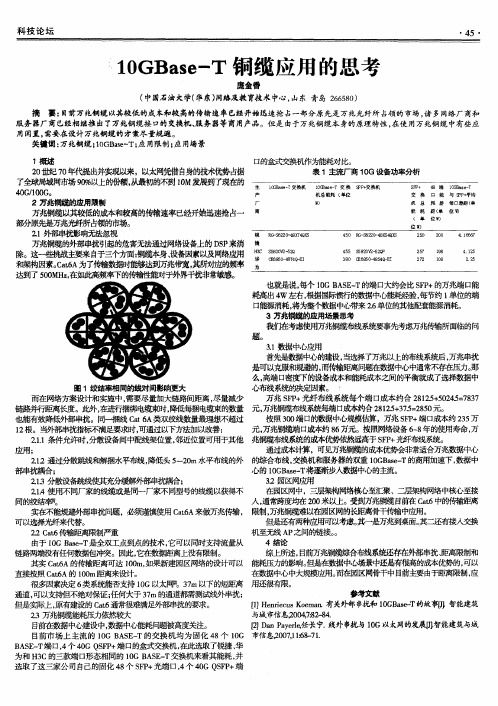
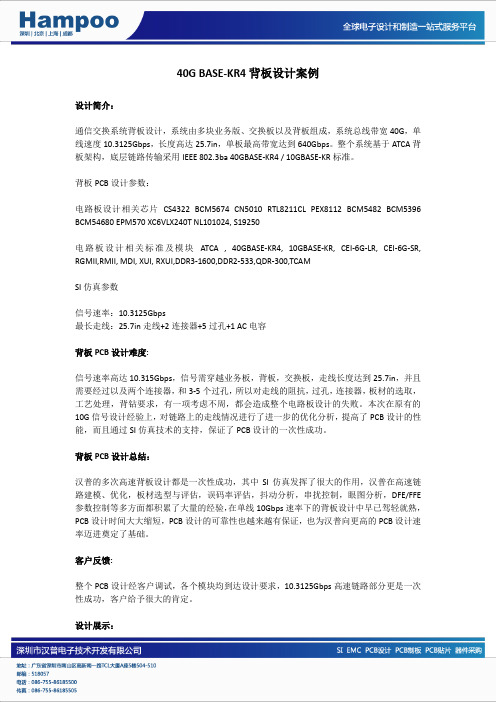
-KR4背板设计案例设计简介:通信交换系统背板设计,系统由多块业务版、交换板以及背板组成,系统总线带宽40G,单线速度10.3125Gbps,长度高达25.7in,单板最高带宽达到640Gbps。
整个系统基于ATCA背板架构,底层链路传输采用IEEE 802.3ba 40GBASE-KR4 / 10GBASE-KR标准。
背板PCB设计参数:电路板设计相关芯片CS4322 BCM5674 CN5010 RTL8211CL PEX8112 BCM5482 BCM5396 BCM54680 EPM570 XC6VLX240T NL101024, S19250电路板设计相关标准及模块ATCA , 40GBASE-KR4, 10GBASE-KR, CEI-6G-LR, CEI-6G-SR, RGMII,RMII, MDI, XUI, RXUI,DDR3-1600,DDR2-533,QDR-300,TCAMSI仿真参数信号速率:10.3125Gbps最长走线:25.7in走线+2连接器+5过孔+1 AC电容背板PCB设计难度:信号速率高达10.315Gbps,信号需穿越业务板,背板,交换板,走线长度达到25.7in,并且需要经过以及两个连接器,和3-5个过孔,所以对走线的阻抗,过孔,连接器,板材的选取,工艺处理,背钻要求,有一项考虑不周,都会造成整个电路板设计的失败。
本次在原有的10G信号设计经验上,对链路上的走线情况进行了进一步的优化分析,提高了PCB设计的性能,而且通过SI仿真技术的支持,保证了PCB设计的一次性成功。
背板PCB设计总结:汉普的多次高速背板设计都是一次性成功,其中SI仿真发挥了很大的作用,汉普在高速链路建模、优化,板材选型与评估,误码率评估,抖动分析,串扰控制,眼图分析,DFE/FFE 参数控制等多方面都积累了大量的经验,在单线10Gbps速率下的背板设计中早已驾轻就熟,PCB设计时间大大缩短,PCB设计的可靠性也越来越有保证,也为汉普向更高的PCB设计速率迈进奠定了基础。

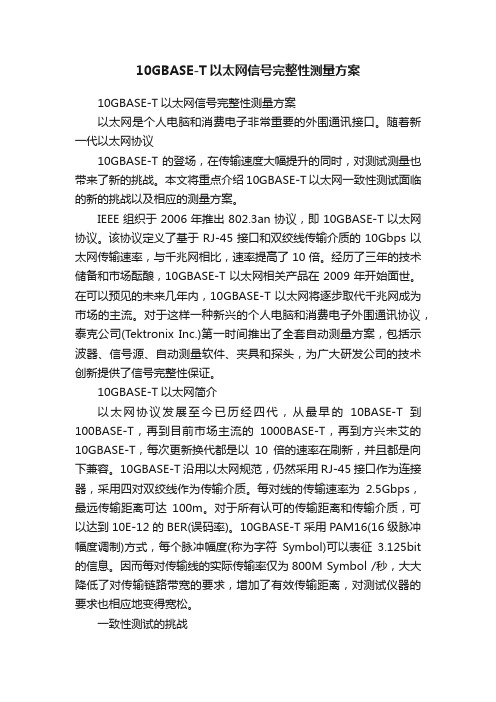
10GBASE-T以太网信号完整性测量方案10GBASE-T以太网信号完整性测量方案以太网是个人电脑和消费电子非常重要的外围通讯接口。
随着新一代以太网协议10GBASE-T的登场,在传输速度大幅提升的同时,对测试测量也带来了新的挑战。
本文将重点介绍10GBASE-T以太网一致性测试面临的新的挑战以及相应的测量方案。
IEEE组织于2006年推出802.3an协议,即10GBASE-T以太网协议。
该协议定义了基于RJ-45接口和双绞线传输介质的10Gbps以太网传输速率,与千兆网相比,速率提高了10倍。
经历了三年的技术储备和市场酝酿,10GBASE-T以太网相关产品在2009年开始面世。
在可以预见的未来几年内,10GBASE-T以太网将逐步取代千兆网成为市场的主流。
对于这样一种新兴的个人电脑和消费电子外围通讯协议,泰克公司(Tektronix Inc.)第一时间推出了全套自动测量方案,包括示波器、信号源、自动测量软件、夹具和探头,为广大研发公司的技术创新提供了信号完整性保证。
10GBASE-T以太网简介以太网协议发展至今已历经四代,从最早的10BASE-T到100BASE-T,再到目前市场主流的1000BASE-T,再到方兴未艾的10GBASE-T,每次更新换代都是以10倍的速率在刷新,并且都是向下兼容。
10GBASE-T沿用以太网规范,仍然采用RJ-45接口作为连接器,采用四对双绞线作为传输介质。
每对线的传输速率为2.5Gbps,最远传输距离可达100m。
对于所有认可的传输距离和传输介质,可以达到10E-12的BER(误码率)。
10GBASE-T采用PAM16(16级脉冲幅度调制)方式,每个脉冲幅度(称为字符Symbol)可以表征3.125bit 的信息。
因而每对传输线的实际传输率仅为800M Symbol /秒,大大降低了对传输链路带宽的要求,增加了有效传输距离,对测试仪器的要求也相应地变得宽松。

VPX技术介绍1VPX 技术新型VPX(VITA 46)标准是自从VME引入后的25年来,对于VME总线架构的最重大也是最重要的改进。
它将增加背板带宽,集成更多的I/O,扩展了格式布局。
目前,VME64x已经不能满足国防和航空领域越来越高的性能要求和更为恶劣环境下的应用。
许多应用,例如雷达,声纳,视频图像处理,智能信号处理等,由于受到VME64x传输带宽的限制,系统性能无法进一步提高。
急需要一种新体制的总线,替代现有的VME64x总线,以提高系统传输带宽。
2B1. VPX标准概述VITA 46基础标准由VITA46.0(基础协议)和VITA46.1(VME连接)描述,也称为VPX,并成功地于2006年一月引入。
这是一个里程碑,因为我们可以确信VITA46标准已经设计和实现出来了。
下一步是完成最终文档,并且提交ANSI(美国国家标准化组织)得到正式ANSI批准。
9B1.1 VPX高速串行总线VPX总线是VME技术的自然进化,它采用高速串行总线替代并行总线是其的最主要变化。
VPX采用RapidIO和Advanced Switching Interconnect等现代的工业标准的串行交换结构,来支持更高的背板带宽。
这些高速串行交换可以提供每个差分对儿250MBytes/sec的数据传输率。
如果4个信道最高1 GBytes/sec的理论速率。
VPX的核心交换提供32个查分对儿,组成4个4信道端口,每个信道都是双向的(一发送差分对儿,一接收差分儿)。
VPX模块的理论合计带宽为8 GB/sec。
当今基于VME总线雷达系统阵列中的每个系统处理器,都必须等待轮到该处理器获得总先后才能发送数据。
这样不仅仅使处理器终止了对当前数据块的处理,同时还终止了处理器对输入数据的处理。
交换结构使所有数据流畅通无阻,来解决这一问题,这样减小了处理延迟和输入数据流的中断。
StarFabric是一个串行转换结构,他利用现有的VME-64背板链接嵌入式多处理器。



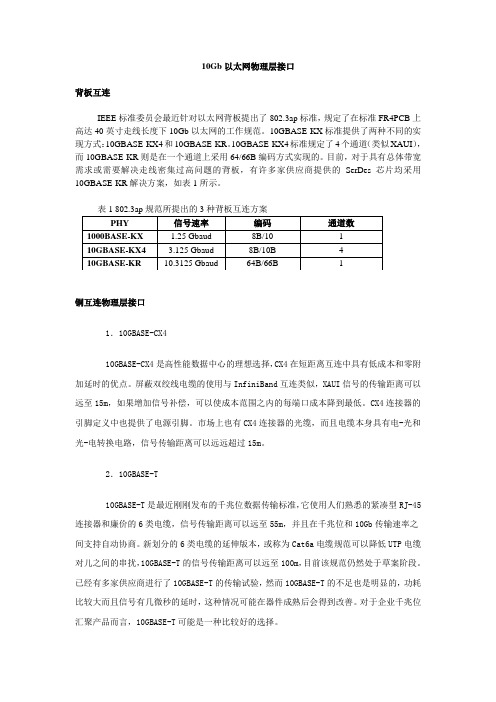
10Gb以太网物理层接口背板互连IEEE标准委员会最近针对以太网背板提出了802.3ap标准,规定了在标准FR4PCB上高达40英寸走线长度下10Gb以太网的工作规范。
10GBASE-KX标准提供了两种不同的实现方式:10GBASE-KX4和10GBASE-KR。
10GBASE-KX4标准规定了4个通道(类似XAUI),而10GBASE-KR则是在一个通道上采用64/66B编码方式实现的。
目前,对于具有总体带宽需求或需要解决走线密集过高问题的背板,有许多家供应商提供的SerDes芯片均采用10GBASE-KR解决方案,如表1所示。
表1 802.3ap规范所提出的3种背板互连方案铜互连物理层接口1.10GBASE-CX410GBASE-CX4是高性能数据中心的理想选择,CX4在短距离互连中具有低成本和零附加延时的优点。
屏蔽双绞线电缆的使用与InfiniBand互连类似,XAUI信号的传输距离可以远至15m,如果增加信号补偿,可以使成本范围之内的每端口成本降到最低。
CX4连接器的引脚定义中也提供了电源引脚。
市场上也有CX4连接器的光缆,而且电缆本身具有电-光和光-电转换电路,信号传输距离可以远远超过15m。
2.10GBASE-T10GBASE-T是最近刚刚发布的千兆位数据传输标准,它使用人们熟悉的紧凑型RJ-45连接器和廉价的6类电缆,信号传输距离可以远至55m,并且在千兆位和10Gb传输速率之间支持自动协商。
新划分的6类电缆的延伸版本,或称为Cat6a电缆规范可以降低UTP电缆对儿之间的串扰,10GBASE-T的信号传输距离可以远至100m,目前该规范仍然处于草案阶段。
已经有多家供应商进行了10GBASE-T的传输试验,然而10GBASE-T的不足也是明显的,功耗比较大而且信号有几微秒的延时,这种情况可能在器件成熟后会得到改善。
对于企业千兆位汇聚产品而言,10GBASE-T可能是一种比较好的选择。
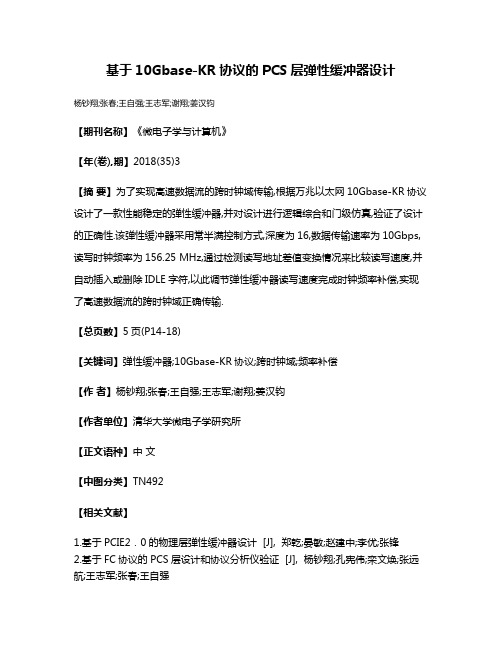
基于10Gbase-KR协议的PCS层弹性缓冲器设计
杨钞翔;张春;王自强;王志军;谢翔;姜汉钧
【期刊名称】《微电子学与计算机》
【年(卷),期】2018(35)3
【摘要】为了实现高速数据流的跨时钟域传输,根据万兆以太网10Gbase-KR协议设计了一款性能稳定的弹性缓冲器,并对设计进行逻辑综合和门级仿真,验证了设计的正确性.该弹性缓冲器采用常半满控制方式,深度为16,数据传输速率为10Gbps,读写时钟频率为156.25 MHz,通过检测读写地址差值变换情况来比较读写速度,并自动插入或删除IDLE字符,以此调节弹性缓冲器读写速度完成时钟频率补偿,实现了高速数据流的跨时钟域正确传输.
【总页数】5页(P14-18)
【关键词】弹性缓冲器;10Gbase-KR协议;跨时钟域;频率补偿
【作者】杨钞翔;张春;王自强;王志军;谢翔;姜汉钧
【作者单位】清华大学微电子学研究所
【正文语种】中文
【中图分类】TN492
【相关文献】
1.基于PCIE2.0的物理层弹性缓冲器设计 [J], 郑乾;晏敏;赵建中;李优;张锋
2.基于FC协议的PCS层设计和协议分析仪验证 [J], 杨钞翔;孔宪伟;栾文焕;张远航;王志军;张春;王自强
3.基于以太网10Gbase-R协议的PCS层设计 [J], 杨钞翔;孔宪伟;栾文焕;张远航;王志军;张春;王自强
4.基于PCIe2.0协议的PCS层弹性缓冲器设计 [J], 武桂林;黄鲁
5.一种多接口协议弹性缓冲器优化设计方法 [J], 樊仕超;贾一平;舒毅;杨海钢
因版权原因,仅展示原文概要,查看原文内容请购买。
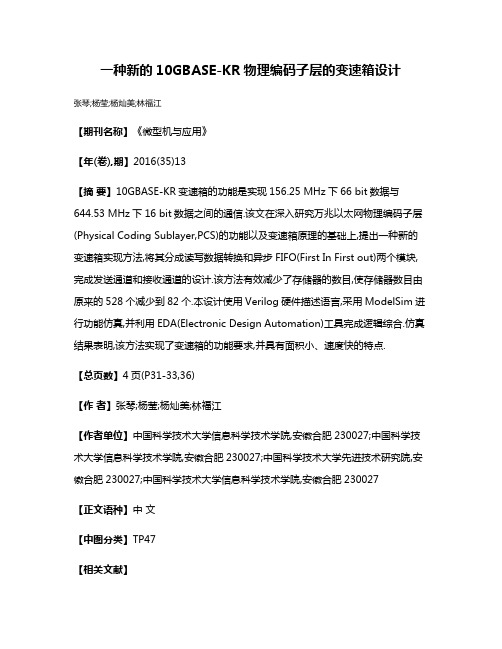
一种新的10GBASE-KR物理编码子层的变速箱设计张琴;杨莹;杨灿美;林福江【期刊名称】《微型机与应用》【年(卷),期】2016(35)13【摘要】10GBASE-KR变速箱的功能是实现156.25 MHz下66 bit数据与644.53 MHz下16 bit数据之间的通信.该文在深入研究万兆以太网物理编码子层(Physical Coding Sublayer,PCS)的功能以及变速箱原理的基础上,提出一种新的变速箱实现方法,将其分成读写数据转换和异步FIFO(First In First out)两个模块,完成发送通道和接收通道的设计.该方法有效减少了存储器的数目,使存储器数目由原来的528个减少到82个.本设计使用Verilog硬件描述语言,采用ModelSim进行功能仿真,并利用EDA(Electronic Design Automation)工具完成逻辑综合.仿真结果表明,该方法实现了变速箱的功能要求,并具有面积小、速度快的特点.【总页数】4页(P31-33,36)【作者】张琴;杨莹;杨灿美;林福江【作者单位】中国科学技术大学信息科学技术学院,安徽合肥230027;中国科学技术大学信息科学技术学院,安徽合肥230027;中国科学技术大学先进技术研究院,安徽合肥230027;中国科学技术大学信息科学技术学院,安徽合肥230027【正文语种】中文【中图分类】TP47【相关文献】1.适用于10 Gbps以太网物理层收发器的变速箱电路设计 [J], 黄安君;罗旸;雷淑岚2.65nm工艺下基于PCI Express2.0协议的物理编码子层设计 [J], 刘奇浩;翁惠辉;张锋;赵建中;吕俊盛;李优3.一种新的异步广播通信系统物理层设计 [J], 杨航;杜兴民4.一种新的异步广播通信系统物理层设计 [J], 杨航;杜兴民5.一种MIMO移动自组织网络的物理层与MAC层联合设计 [J], 朴德江;肖子雄;蒋轶因版权原因,仅展示原文概要,查看原文内容请购买。

创意电子发表10GBase-KR多标准串行器/解串器
(SerDes)IP
佚名
【期刊名称】《中国集成电路》
【年(卷),期】2012(000)007
【摘要】创意电子(GUC)日前宣布,该公司已成功开发第二代10GBase--KR 多标准串行器/解串器IP,通过硅品验证并开始提供给客户进行设计。
GUC的MSKRSerDes满足当今要求最严苛的高阶网络与运算需求,传输速度从1.25Gb /s到高达12.5Gb/s;支援多重传输标准,
【总页数】1页(P15-15)
【正文语种】中文
【中图分类】TN949.197
【相关文献】
1.飞兆半导体推出串化器/解串器(SerDes)装置 [J],
2.飞兆半导体串化器/解串器(SerDes)装置 [J],
3.飞兆半导体突破性的μSerDes串化器/解串器技术达到业界最低的耗电量 [J],
4.Maxim推出高速LVDS串行器解串器(SerDes)新产品 [J],
5.Maxim Integrated推出串行器/解串器(SerDes)芯片组 [J],
因版权原因,仅展示原文概要,查看原文内容请购买。